















- Locations
- United States
- US Blogs
- Health Equity in the Time of COVID-19
The COVID-19 pandemic was (and still is) a global health crisis, yet it was not a universal experience. Black, Latinx, and Indigenous Americans died from COVID-19 at disproportionately high rates,1,2 in part due to the greater prevalence of hypertension, diabetes, and obesity in these groups.3 These disparities illuminated a much larger problem, where disease and treatment are not equally experienced, and where social circumstance can have a devastating impact on outcomes. This reckoning around health equity and the disparities that have been long documented, but rarely highlighted, is overdue. It is also a profound opportunity for healthcare – and especially life sciences organizations – to apply the rigor of data science and the understanding of human science to articulate and address the problem.
Preventive health visits (both access to and utilization of) are good bellwethers of health equity. First, because they are typically fully covered by insurance plans under the Affordable Care Act (ACA),4 barriers to visits are often more complicated than just financial. Second, by definition, preventive care is not mandatory, and therefore represents an opportunity not just for treatment, but for more holistic care; a wellness visit is an opportunity for individuals to develop a relationship with a healthcare provider. Finally, these visits are often (and ideally) the early-action trigger of a longer, more complicated journey. The most valuable or productive preventive health visits result in early detection of diseases before costly and aggressive treatments are necessary. This is especially true for chronic diseases, such as heart disease, diabetes, kidney disease, and chronic respiratory diseases, which are responsible for more than a third of deaths in the U.S. each year5 – yet can be effectively managed.
Unfortunately, even before the pandemic, preventive care was under-utilized. In the U.S., CDC data from 2015 suggests only 8% of adults aged 35 years and over received all of the recommended clinical preventive services, and utilization varied by race/ethnicity, age, sex, and poverty level.6 During the COVID-19 pandemic lockdown, preventive health appointments plummeted, exacerbating disparities and signaling long-term problems for the system; by the end of 2020, approximately 8.5 million adults had missed a preventive health visit – making a dire situation worse.
As a partner dedicated to the development and delivery of equitable healthcare, IQVIA is uniquely able to leverage a range of nonidentified data sets to glean insights into who was most impacted by missed routine healthcare visits during COVID-19 pandemic lockdown. The following report offers a preliminary view of how social determinants of health correlated with preventive care during the pandemic.
The aim of this work is to present the complicated evidence of differences in access and use of healthcare, and ultimately enable action on these insights to build a pathway to improved and equitable patient care.
Methodology
This analysis used IQVIA’s open claims database to identify patients 18 years or older who had a preventive health visit between 2017 – 2020. The data was then projected to represent the entire population. Adstra Consumer Demographics data was appended to de-identified data at the patient level and aggregated to understand how preventive care visits correlated with social determinants of health, such as sex, age, race/ethnicity, and education attainment.
The result was a cohort of eight million matched, unique patients from 2017 – 2020 (the same patient was allowed to be included in multiple years). The procedures performed within three months of a preventive health visit were also assessed.
Key Insights
8.5 million adults missed a preventive health visit in 2020
Exhibit 1: Adults with a preventive health visit, 2017 – 2020; projected and actual year-over-year growth trends, 2018–2020
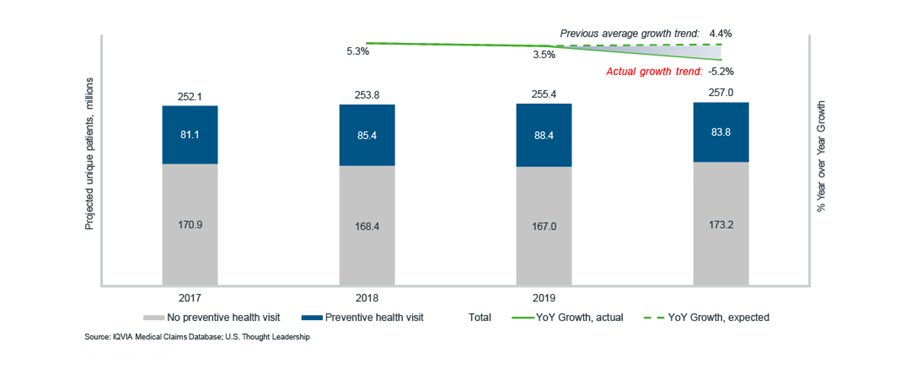
From 2017 to 2019, the number of adults with a routine health visit grew an average of 4.4% each year (Exhibit 1). In the absence of COVID-19, that growth was expected to continue, meaning an additional 3.9 million adults were expected to be seen. However, the number of adults seen in 2020 declined by 5.2%, equivalent to 4.6 million adults. The compounded effect of lost expected growth and further attrition means 8.5 million patients did not have a visit. This many missing patients will likely contribute to the ripple of more severe disease presentation over the coming years.
All races/ethnicities missed care, but the gap was largest for Asian patients
Exhibit 2: Percent change in number of patients, 2018–2020; projected and actual year-over-year growth trends, 2018–2020
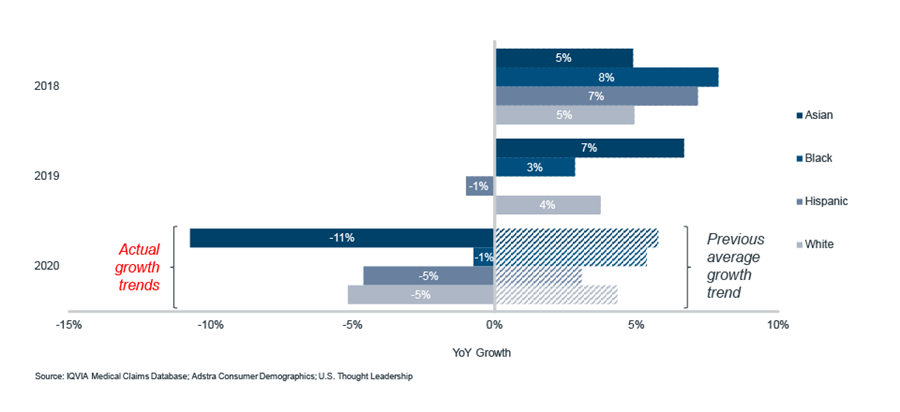
All race/ethnicity groups saw a decline in preventative care visits in 2020, but Asian individuals saw the greatest decline compared to 2019 (Exhibit 2). This demographic was expected to grow by 6%, but saw an 11% decline. While it is tempting to interpret this gap as evidence of a significant imposed healthcare disparity, the layering of other social determinants of health highlights the complexity of health equity research, which will be further explored in the education section (below).
Female adults missed more visits than male adults, compounding existing sex differences
Exhibit 3: Percent of adult population with a preventive health visit by sex, 2018–2020; Percent of missing patients by sex, 2020
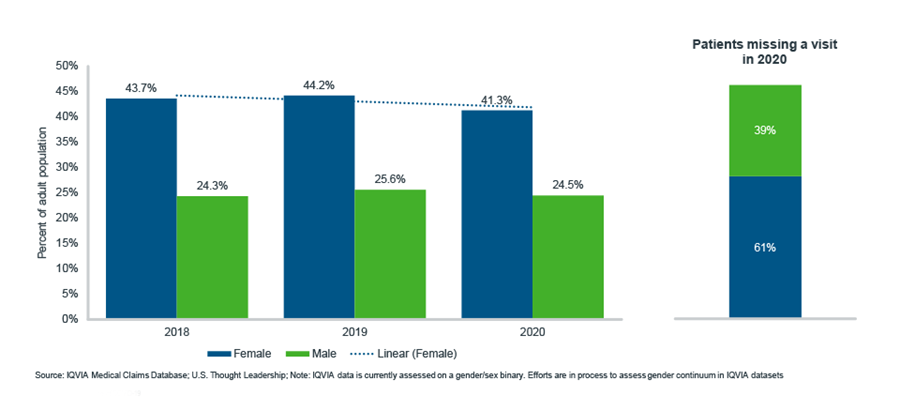
Female adults typically utilize preventative health visits more than their male counterparts, largely due to breast cancer and gynecological screenings (Exhibit 3). Expectedly, they bore the brunt of visit disruption in 2020 and represented 61% of missing patients. In a typical year, only approximately 25% of male adults have a preventative health visit – however, there is evidence of increased utilization among male adults (Exhibit 4). Male adult utilization growth rates exceed those of female adults and experienced more drastic drops in 2020. Progress in getting male adults into routine visits may be lost and difficult to recoup.
Exhibit 4: Year-over-year growth in patients by sex and race/ethnicity, 2018–2020
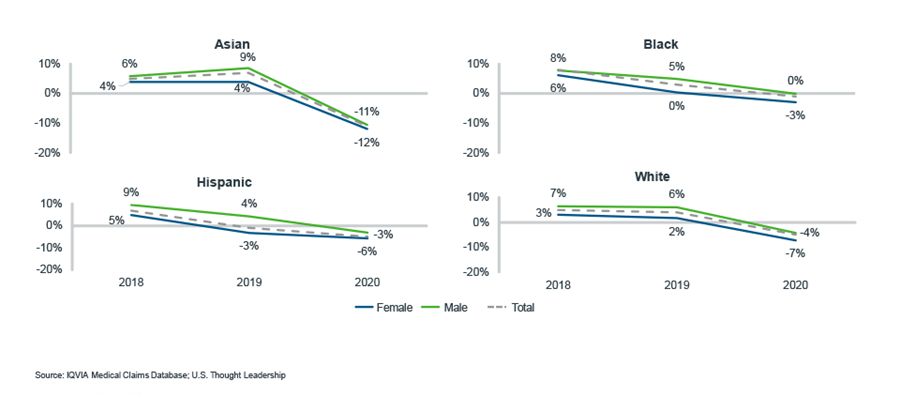
Despite the greater risk, senior wellness was prioritized
Exhibit 5: Percent change in patients with a preventive health visit by sex and age, 2019–2020
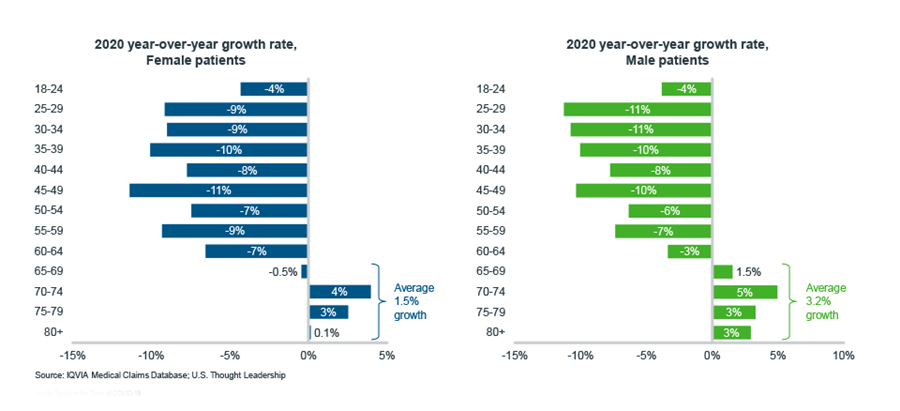
Patients under 65 years old missed more preventative health visits in 2020, while patients over 65 saw an average of 2.3% growth in utilization compared to 2019 (Exhibit 5). It was a pandemic balancing act: those who needed care the most were often most at risk. And while providers tried to mitigate risk and ensure that those who needed care received it, individual agency also played into decision making. So although disparities in access did drive some cancelations, younger patients were still triaged by healthcare professionals and/or chose to forgo visits, believing a routine healthcare visit was not worth the risk of infection. Older patients, on the other hand, proved to be more proactive in receiving care and were prioritized by healthcare providers due to the increased risk of severe COVID-19 in this age group.
Adults with higher education were more risk averse
Exhibit 6: Percent change in patients with preventive visit by race/ethnicity and education attainment, 2019–2020
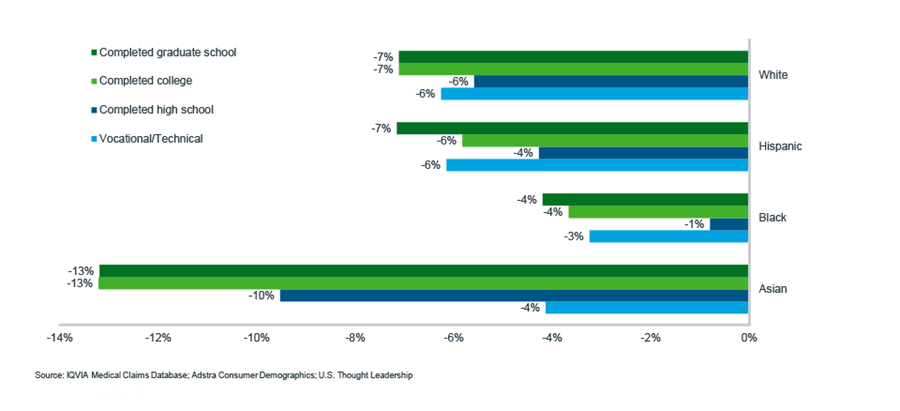
Across all races/ethnicities, adults with higher levels of education, namely those who completed college and graduate school, saw the greatest declines in visits when compared to other education categories (Exhibit 6). As alluded to earlier, Asian individuals had the overall greatest declines –13% – in both of those education attainment groups, meaning their visit loss is not necessarily a discriminatory or the result of lack of access. Complex decision making and perception of risk mitigation may differ across education attainment and race/ethnicity, underscoring the importance of a holistic picture of an individual’s circumstance.
Everyone spent less time with their HCP, especially Black patients
Exhibit 7: Change in patients with preventive visits by visit duration (minutes) by race/ethnicity, 2019–2020
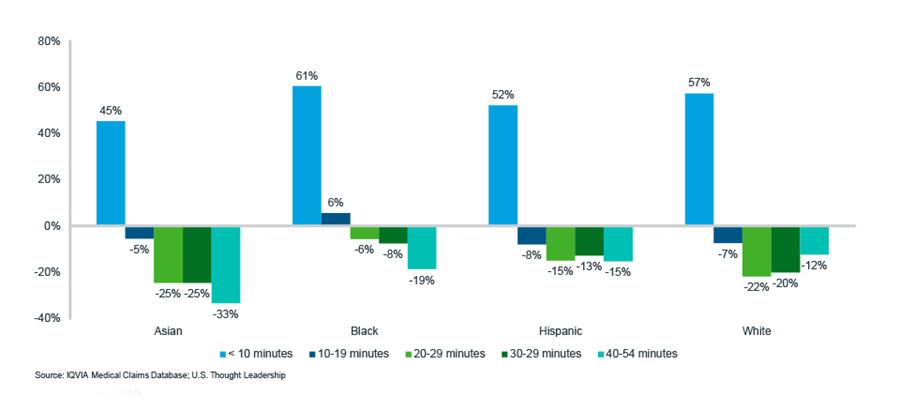
As healthcare providers and individuals walked the COVID-19 tightrope, shorter visits emerged as a way to deliver care, mitigate infection risk, and try to recover lost visits resulting from the pandemic lockdown in spring of 2020. All races/ethnicities saw a rise in shorter visits (Exhibit 7). However, Black patients had the greatest increase in visits lasting less than 10 minutes, and were the only group to see a rise in visits lasting less than 20 minutes. While everyone found themselves in a difficult position, the dearth of face time affecting one group over another – especially one that has been systematically and historically excluded or underserved – is significant cause for concern and a clear area for action.
Procedures in 2021 return to a pre-pandemic context
Exhibit 8: Top 10 procedures performed within three months of a preventive visit, 2019 – Q1 2021
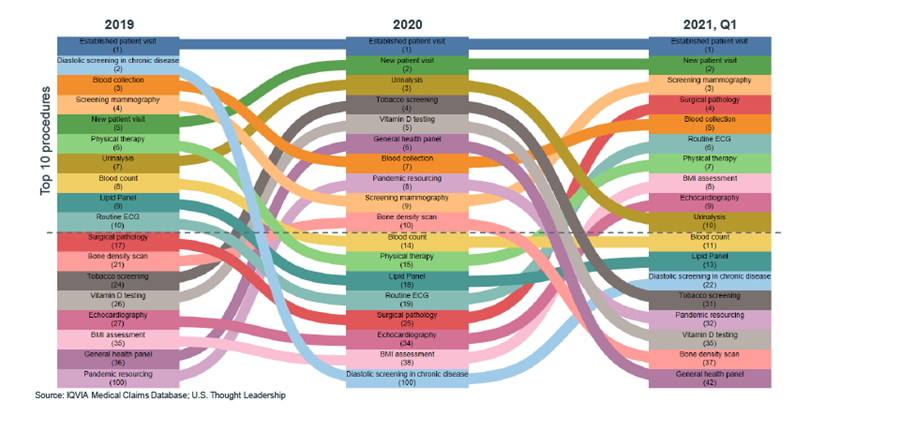
In Q1 2021, before the Delta variant surge, the most frequent procedures more closely resembled the top procedures in 2019, including more in-person procedures (Exhibit 8). Interestingly, biopsies were more common than in other periods, indicating critical care that may have been delayed in 2020 just began reaching patients in 2021. As expected, age-related procedures, like bone density scans, are less frequent, as older patients are no longer prioritized at the preventative health level.
Looking Ahead
Even a brief consideration of the large number of Social Determinants of Health across which disparities exist illustrates the tremendous complexity of this topic. Additional insights can surely be garnered by assessing the interplay of additional Social Determinants of Health and understanding the relationships between them through multivariate analyses. This is the beginning of a journey that will require humility, collaboration across the healthcare ecosphere, and most importantly, consideration of the human experience.
References:
- Price-Haygood EG, Burton J, et al. Hospitalization and Mortality among Black Patients and White Patients with Covid-19. N Engl J Med. 2020. DOI: https://doi.org/10.1056/NEJMsa2011686external icon.
- Wadhera RK, Wadhera P, Gaba P, Figueroa JF, Joynt Maddox KE, Yeh RW, & Shen C. Variation in COVID-19 Hospitalizations and Deaths Across New York City Boroughs. JAMA. 2020;323(21),2192–2195. https://doi.org/10.1001/jama.2020.7197external icon.
- REACH | CDC, accessed in October 2021
- Coverage of Certain Preventive Services Under the Affordable Care Actexternal icon; U.S. Department of Health & Human Services. July 2015
- Centers for Disease Control and Prevention, National Center for Health Statistics. Underlying Cause of Death 1999-2019 on CDC WONDER Online Database, released in 2020. Data are from the Multiple Cause of Death Files, 1999-2019, as compiled from data provided by the 57 vital statistics jurisdictions through the Vital Statistics Cooperative Program. Accessed at http://wonder.cdc.gov/ucd-icd10.html on Oct 29, 2021 4:15:46 PM
- Medical Expenditure Panel Survey - Preventive Services Self-Administered Questionnaire (MEPS Preventive Services Survey), 2014




